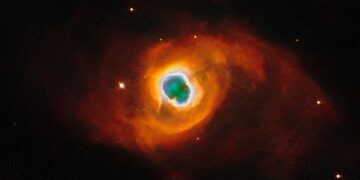The universe recently unveiled a stunning cosmic eulogy, captured by none other than the NASA/ESA Hubble Space Telescope. This image, showcasing the planetary nebula Kohoutek 4-55, is not just a celestial spectacle but also the swan song of one of Hubble’s most iconic instruments, the Wide Field and Planetary Camera 2 (WFPC2).
Kohoutek 4-55: A Dying Star’s Last Act
Planetary nebulae are among the most visually captivating phases in a star’s life cycle, and Kohoutek 4-55 is no exception.
The colorful layers in Kohoutek 4-55 are made of gas expelled by a dying red giant star. As the star nears the end of its life, it sheds its outer layers into space, exposing a hot, dense core. This core radiates intense ultraviolet (UV) light, ionizing the ejected gas and making it glow in vibrant hues. According to NASA, the image reveals red and orange for nitrogen, green for hydrogen, and blue for oxygen. These colors aren’t just for show—they help scientists trace the chemical composition and structure of the nebula.
This nebula’s structure is also unusual. Unlike more symmetrical planetary nebulae, Kohoutek 4-55 exhibits a faint outer halo, a bright central ring, and multiple layers of ionized gas, giving it a complex, three-dimensional appearance. This layered form may hint at episodic mass loss or varying stellar winds during the star’s final phases.
The vivid glow we see is fleeting. Once the remaining nuclear fusion ends, the star’s core will cool into a white dwarf, and the surrounding clouds will gradually dissipate over tens of thousands of years—a brief moment in cosmic time.
WFPC2 captured its final image just ten days before being removed from Hubble in 2009. Installed in 1993 during a servicing mission, the Wide Field and Planetary Camera 2 was responsible for many of Hubble’s most iconic discoveries, including the famous Hubble Deep Field and observations of comet Shoemaker-Levy 9 striking Jupiter. According to NASA, the image of Kohoutek 4-55 was its last contribution before being replaced by the Wide Field Camera 3.
This adds a rich layer of symbolism to the photograph. Just as the nebula represents the last breath of a star, the image itself serves as a closing chapter for a camera that transformed our view of the universe. It’s a passing of the torch, both literally and metaphorically.
Why Planetary Nebulae Matter in Modern Astrophysics
Kohoutek 4-55 is more than just a beautiful picture. It’s a window into the processes that shape stars, galaxies, and even the conditions necessary for life.
Planetary nebulae help astronomers understand how stars die and what they leave behind. As stars eject their outer layers, they release elements like carbon, nitrogen, and oxygen into the surrounding space. This process enriches the interstellar medium with the raw materials needed to form new stars, planets, and potentially life-bearing systems.
According to the European Space Agency (ESA), such nebulae serve as cosmic recycling centers. The death of one star contributes to the birth of another. Studying these structures helps refine models of stellar evolution, including predictions about how long stars of different masses live and how they change over time.
In Kohoutek 4-55’s case, the layered structure may inform us about irregularities in mass loss, suggesting new pathways in stellar wind theory or pulsation models. The more detailed the observation, the deeper the insights into the mechanics of dying stars.
A Glimpse Into Our Own Future
Understanding planetary nebulae also means understanding the future of our Sun.
In about 5 billion years, our Sun will become a red giant and eventually form a planetary nebula. The Sun will swell, shed its outer layers, and leave behind a white dwarf—much like what we see in Kohoutek 4-55. Observing such systems offers a preview of what lies ahead for our solar system.
As we watch stars like ours go through their final phases, we gather clues about the fate of Earth and the potential lifespan of habitable environments. This adds a personal dimension to the science: we’re not just studying distant objects; we’re looking into a cosmic mirror.
Moreover, the elements forged and spread by dying stars play a critical role in forming Earth-like planets. Oxygen in our atmosphere, calcium in our bones, and iron in our blood were all forged in stellar interiors and distributed by events like those captured in Kohoutek 4-55.
Hubble’s Legacy and Continuing the Exploration
The WFPC2 helped revolutionize astrophysics, delivering sharp images that expanded our understanding of the cosmos. From measuring the rate of the universe’s expansion to peering into the dusty cradles of star birth, its contributions are invaluable. The image of Kohoutek 4-55 is a poetic bookend to this legacy.
Even though WFPC2 is gone, its successor, Wide Field Camera 3, continues the mission. Future telescopes like the James Webb Space Telescope (JWST) and ESA’s Euclid are set to provide even deeper views, exploring everything from exoplanets to dark energy.
Yet, this image remains a powerful reminder of the human drive to explore, understand, and connect with the universe. It’s a legacy framed in light—the last light of a dying star, captured by a retiring camera, offered to humanity as both science and art.
Conclusion
The image of Kohoutek 4-55 is not just an astronomical observation—it is a narrative woven across space and time. It encapsulates the death of a star, the conclusion of a telescope instrument’s mission, and the continuation of human curiosity. As we marvel at this beautiful nebula, we are reminded that even endings can be luminous, poetic, and full of meaning.



















